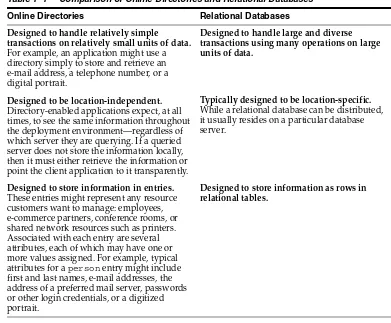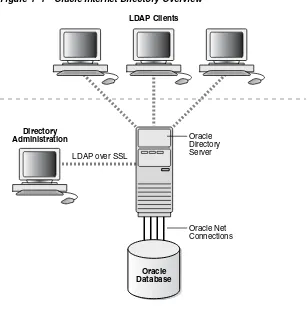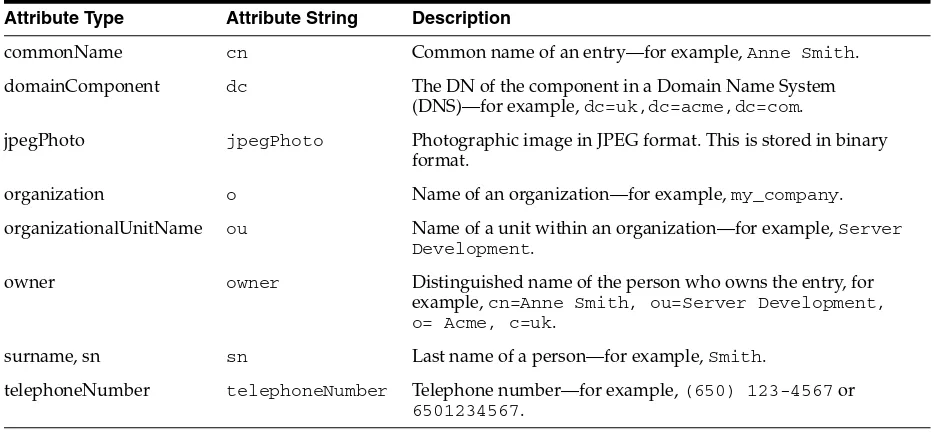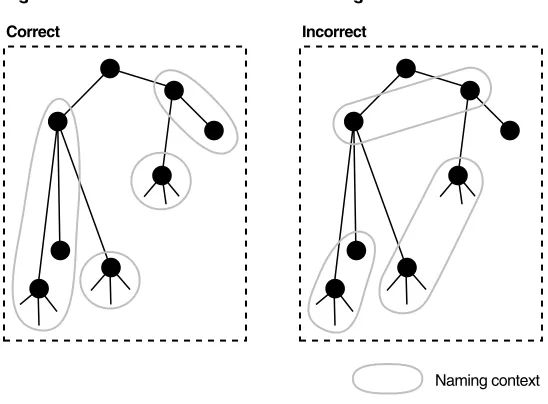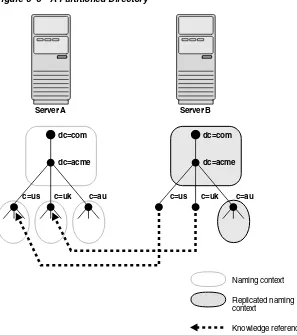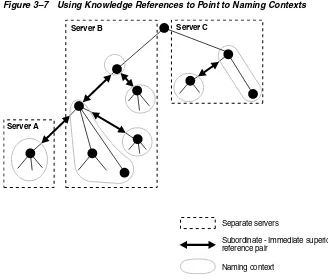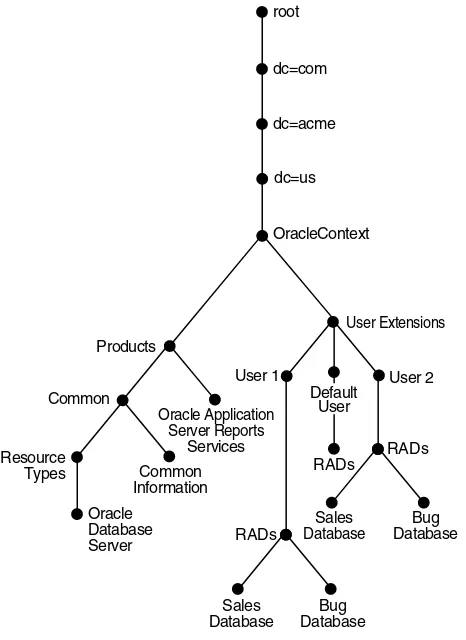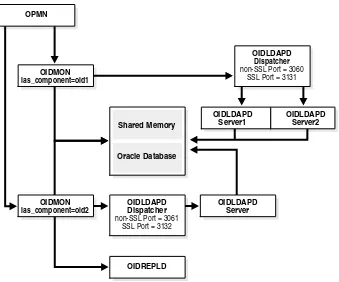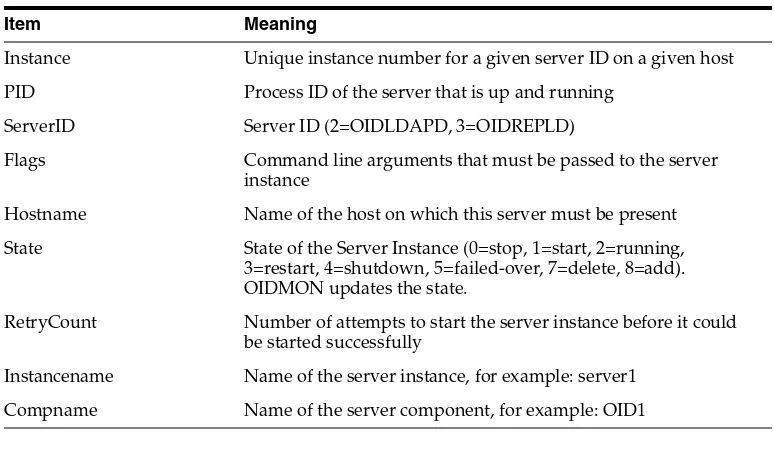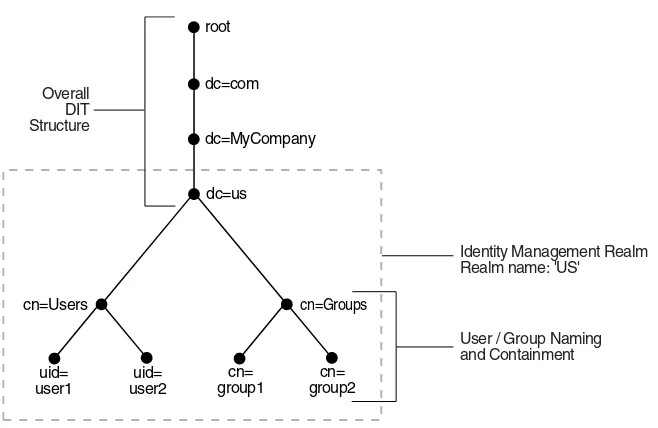Oracle® Fusion Middleware
Administrator's Guide for Oracle Internet Directory
11
g
Release 1 (11.1.1)
E10029-03
Oracle Fusion Middleware Administrator's Guide for Oracle Internet Directory, 11g Release 1 (11.1.1)
E10029-03
Copyright © 1999, 2011, Oracle and/or its affiliates. All rights reserved.
Primary Author: Ellen Desmond
Contributors: Olfat Aly, Krishna Chander, Giriraj Chauhan, Margaret Chou, Quan Dinh, Maud Jamati-Bartlett, Vinoth Janakiraman, Buddhika Kottahachchi, Venkat Medam, Vishal Parashar, Karthi Purushothaman, Lakshmi Ramadoss, Loganathan Ramasamy, Ramaprakash Sathyanarayan, Daniel Shih, Olaf Stullich, Dipankar Thakuria, Arun Theebaprakasam, Vinay Thulasidas, Satishkumar Venkatasamy, Frances Wu
This software and related documentation are provided under a license agreement containing restrictions on use and disclosure and are protected by intellectual property laws. Except as expressly permitted in your license agreement or allowed by law, you may not use, copy, reproduce, translate, broadcast, modify, license, transmit, distribute, exhibit, perform, publish, or display any part, in any form, or by any means. Reverse engineering, disassembly, or decompilation of this software, unless required by law for interoperability, is prohibited.
The information contained herein is subject to change without notice and is not warranted to be error-free. If you find any errors, please report them to us in writing.
If this software or related documentation is delivered to the U.S. Government or anyone licensing it on behalf of the U.S. Government, the following notice is applicable:
U.S. GOVERNMENT RIGHTS Programs, software, databases, and related documentation and technical data delivered to U.S. Government customers are "commercial computer software" or "commercial technical data" pursuant to the applicable Federal Acquisition Regulation and agency-specific supplemental regulations. As such, the use, duplication, disclosure, modification, and adaptation shall be subject to the restrictions and license terms set forth in the applicable Government contract, and, to the extent applicable by the terms of the Government contract, the additional rights set forth in FAR 52.227-19, Commercial Computer Software License (December 2007). Oracle USA, Inc., 500 Oracle Parkway, Redwood City, CA 94065.
This software is developed for general use in a variety of information management applications. It is not developed or intended for use in any inherently dangerous applications, including applications which may create a risk of personal injury. If you use this software in dangerous applications, then you shall be responsible to take all appropriate fail-safe, backup, redundancy, and other measures to ensure the safe use of this software. Oracle Corporation and its affiliates disclaim any liability for any damages caused by use of this software in dangerous applications.
Oracle is a registered trademark of Oracle Corporation and/or its affiliates. Other names may be trademarks of their respective owners.
This software and documentation may provide access to or information on content, products, and services from third parties. Oracle Corporation and its affiliates are not responsible for and expressly disclaim all warranties of any kind with respect to third-party content, products, and services. Oracle Corporation and its affiliates will not be responsible for any loss, costs, or damages incurred due to your access to or use of third-party content, products, or services.
RSA and RC4 are trademarks of RSA Data Security. Portions of Oracle Internet Directory have been licensed by Oracle Corporation from RSA Data Security.
Contents
Preface
... xxxviiAudience... xxxvii
Documentation Accessibility ... xxxvii
Related Documents ... xxxviii
Conventions ... xxxix
What's New in Oracle Internet Directory?
... xliNew Features Introduced with Oracle Internet Directory 11g Release 1 (11.1.1.4.0) ... xli New Features Introduced with Oracle Internet Directory 11g Release 1 (11.1.1) ... xlii New Features Introduced with Oracle Internet Directory 10g (10.1.4.1) ... xliv New Features Introduced with Oracle Internet Directory 10g Release 2 (10.1.2)... xlvi
Part I
Understanding Directory Services
1
Introduction to Directory Services
What Is a Directory?... 1-1 The Expanding Role of Online Directories... 1-1 The Problem: Too Many Special-Purpose Directories ... 1-2
What Is the Lightweight Directory Access Protocol (LDAP)?... 1-3 LDAP and Simplified Directory Management ... 1-3 LDAP Version 3... 1-3
What Is Oracle Internet Directory?... 1-4 Overview of Oracle Internet Directory ... 1-4 Components of Oracle Internet Directory ... 1-5 Advantages of Oracle Internet Directory ... 1-5 Scalability ... 1-6 High Availability ... 1-6 Security ... 1-6 Integration with the Oracle Environment ... 1-6
2
Understanding Oracle Internet Directory in Oracle Fusion Middleware
WebLogic Server Domain... 2-1
Oracle Internet Directory as a System Component... 2-2
Oracle Internet Directory Deployment Options... 2-2
Middleware Home... 2-3
WebLogic Server Home... 2-3
Oracle Common Home... 2-3
Oracle Home ... 2-3
Oracle Instance ... 2-3
Oracle Enterprise Manager Fusion Middleware Control... 2-4
Logging, Auditing, and Diagnostics... 2-4
MBeans and the WebLogic Scripting Tool... 2-4
3
Understanding Oracle Internet Directory Concepts and Architecture
Oracle Internet Directory Architecture... 3-1 An Oracle Internet Directory Node ... 3-2 An Oracle Directory Server Instance... 3-3 Oracle Internet Directory Ports ... 3-4 Directory Metadata ... 3-4
How Oracle Internet Directory Processes a Search Request... 3-6
Directory Entries... 3-7 Distinguished Names (DNs) and Directory Information Trees (DITs)... 3-7 Entry Caching ... 3-8
Attributes... 3-8 Kinds of Attribute Information ... 3-9 Single-Valued and Multivalued Attributes... 3-10 Common LDAP Attributes ... 3-10 Attribute Syntax ... 3-11 Attribute Matching Rules... 3-11 Attribute Options ... 3-11
Object Classes... 3-12 Subclasses, Superclasses, and Inheritance... 3-12 Object Class Types ... 3-13 Structural Object Classes... 3-13 Auxiliary Object Classes ... 3-13 Abstract Object Classes ... 3-13
Naming Contexts... 3-14
Security... 3-14
Globalization Support... 3-15
Distributed Directories... 3-16 Directory Replication... 3-16 Directory Partitioning... 3-16
Knowledge References and Referrals... 3-17
Oracle Delegated Administration Services and the Oracle Internet Directory Self-Service Console... 3-19
Oracle Internet Directory and Identity Management... 3-20 About Identity Management ... 3-21 Oracle Identity Management Products ... 3-21 Identity Management Realms ... 3-23 Default Identity Management Realm... 3-23 Identity Management Policies... 3-23
Resource Information... 3-24 Resource Type Information ... 3-24 Resource Access Information ... 3-24 Location of Resource Information in the DIT ... 3-24
4
Understanding Process Control of Oracle Internet Directory Components
Oracle Internet Directory Process Control Architecture... 4-1
The ODS_PROCESS_STATUS Table... 4-2
Starting, Stopping, and Monitoring of Oracle Internet Directory Processes... 4-3 Oracle Internet Directory Snippet in opmn.xml ... 4-3 OPMN Starting Oracle Internet Directory... 4-4 OPMN Stopping of Oracle Internet Directory ... 4-4 Process Monitoring ... 4-5
Oracle Internet Directory Process Control–Best Practices... 4-5
5
Understanding Oracle Internet Directory Organization
The Directory Information Tree... 5-1
Planning the Overall Directory Structure... 5-2
Planning the Names and Organization of Users and Groups... 5-3 Organizing Users... 5-3 Organizing Groups ... 5-4
Migrating a DIT from a Third-Party Directory... 5-5
6
Understanding Oracle Internet Directory Replication
Why Use Replication?... 6-2
Replication Concepts... 6-2 Content to be Replicated: Full or Partial... 6-2 Direction: One-Way, Two-Way, or Peer to Peer... 6-3 Transport Mechanism: LDAP or Oracle Database Advanced Replication... 6-4 Directory Replication Group (DRG) Type: Single-master, Multimaster, or Fan-out ... 6-4 Single-Master Replication Example ... 6-5 Multimaster Replication Example ... 6-5 Fan-out Replication Example ... 6-6 Loose Consistency Model ... 6-6 How the Replication Concepts Fit Together ... 6-6 Multimaster Replication with Fan-Out... 6-7
What Kind of Replication Do You Need?... 6-8
7
Getting Started With Oracle Internet Directory
Patching Your System to 11g Release 1 (11.1.1.4.0)... 7-1 Deselecting Cipher Suites for SSL Server Authentication ... 7-1 Upgrading a Directory Replication Group... 7-2
Postinstallation Tasks and Information... 7-2 Setting Up the Environment ... 7-2 Starting and Stopping the Oracle Stack ... 7-2 Identifying Default URLs and Ports... 7-2 Tuning Oracle Internet Directory ... 7-2 Enabling Anonymous Binds... 7-3 Enabling Oracle Internet Directory to run on Privileged Ports... 7-3 Verifying Oracle Database Time Zone ... 7-3
Using Fusion Middleware Control to Manage Oracle Internet Directory ... 7-4
Using Oracle Directory Services Manager... 7-5 Introduction to Oracle Directory Services Manager ... 7-6 Using the JAWS Screen Reader with Oracle Directory Services Manager ... 7-6 Non-Super User Access to Oracle Directory Services Manager ... 7-6 Single Sign-On Integration with Oracle Directory Services Manager... 7-6 Configuring ODSM for SSO Integration... 7-7 Configuring the SSO Server for ODSM Integration... 7-8 Configuring the Oracle HTTP Server for ODSM-SSO Integration ... 7-9 Invoking Oracle Directory Services Manager ... 7-9 Connecting to the Server from Oracle Directory Services Manager... 7-9 Logging in to the Directory Server from Oracle Directory Services Manager... 7-10 Logging Into the Directory Server from Oracle Directory Services Manager Using SSL ... 7-11
Connecting to an SSO-Enabled Directory as an SSO-Authenticated User ... 7-12 Configuring Oracle Directory Services Manager Session Timeout ... 7-12 Configuring Oracle HTTP Server to Support Oracle Directory Services Manager in an Oracle WebLogic Server Cluster 7-12
Using Command-Line Utilities to Manage Oracle Internet Directory... 7-13 Using Standard LDAP Utilities... 7-13 Using Bulk Tools ... 7-14 Using WLST ... 7-14
Basic Tasks for Configuring and Managing Oracle Internet Directory ... 7-15
8
Managing Oracle Internet Directory Instances
Introduction to Managing Oracle Internet Directory Instances ... 8-1 The Instance-Specific Configuration Entry ... 8-1 Creating the First Oracle Internet Directory Instance... 8-2 Creating Additional Oracle Internet Directory Instances ... 8-3 Registering an Oracle Instance or Component with the WebLogic Server ... 8-4
Managing Oracle Internet Directory Components by Using opmnctl... 8-5 Creating an Oracle Internet Directory Component by Using opmnctl ... 8-6 Registering an Oracle Instance by Using opmnctl ... 8-7 Unregistering an Oracle Instance by Using opmnctl... 8-7 Updating the Component Registration of an Oracle Instance by Using opmnctl... 8-8 Deleting an Oracle Internet Directory Component by Using opmnctl ... 8-9 Viewing Active Server Instance Information by Using opmnctl ... 8-9 Starting the Oracle Internet Directory Server by Using opmnctl... 8-9 Stopping the Oracle Internet Directory Server by Using opmnctl... 8-10 Restarting the Oracle Internet Directory Server by Using opmnctl... 8-10 Changing the Oracle Database Information in opmn.xml ... 8-10
Starting an Instance of the Replication Server by Using OIDCTL... 8-10
9
Managing System Configuration Attributes
Introduction to Managing System Configuration Attributes... 9-1 What are Configuration Attributes?... 9-1 What are Operational Attributes?... 9-2 Attributes of the Instance-Specific Configuration Entry ... 9-2 Attributes of the DSA Configuration Entry ... 9-9 Attributes of the DSE ... 9-10
Managing System Configuration Attributes by Using Fusion Middleware Control... 9-11 Configuring Server Properties ... 9-11 Configuring Shared Properties ... 9-13 Configuring Other Parameters... 9-14
Managing System Configuration Attributes by Using WLST... 9-14
Managing System Configuration Attributes by Using LDAP Tools... 9-16 Setting System Configuration Attributes by Using ldapmodify ... 9-16 Listing Configuration Attributes with ldapsearch... 9-17
Managing System Configuration Attributes by Using ODSM Data Browser... 9-18 Navigating to the Instance-Specific Configuration Entry ... 9-18 Navigating to the DSA Configuration Entry ... 9-18 Navigating to the DSE Root... 9-18
10
Managing IP Addresses
Introduction to Managing IP Addresses... 10-1
Configuring an IP Address for IP V6, Cold Failover Cluster, or Virtual IP... 10-1
11
Managing Naming Contexts
Introduction to Managing Naming Contexts... 11-1
Searching for Published Naming Contexts... 11-1
Publishing a Naming Context... 11-2
12
Managing Accounts and Passwords
Introduction to Managing Accounts and Passwords... 12-1
Enabling and Disabling Accounts by Using Command-Line Tools... 12-2 Unlocking Accounts by Using Command-Line Tools... 12-3 Forcing a Password Change by Using Command-Line Tools... 12-3
Managing Accounts and Passwords by Using the Self-Service Console... 12-3 Enabling and Disabling Accounts by Using the Oracle Internet Directory Self-Service Console.. 12-4
Unlocking Accounts by Using the Oracle Internet Directory Self-Service Console... 12-4 Resetting Your Own Password by Using the Oracle Internet Directory Self-Service Console ... 12-4
Listing and Unlocking Locked Accounts by Using Oracle Directory Services Manager... 12-4
Changing the Superuser Password by Using Fusion Middleware Control... 12-5
Creating Another Account With Superuser Privileges... 12-5
Managing the Superuser Password by Using ldapmodify... 12-6
Changing the Oracle Internet Directory Database Password... 12-6
Resetting the Superuser Password... 12-7
Changing the Password for the EMD Administrator Account... 12-7
Changing the Password for the ODSSM Administrator Account... 12-8
13
Managing Directory Entries
Introduction to Managing Directory Entries... 13-1
Managing Entries by Using Oracle Directory Services Manager... 13-1 Displaying Entries by Using Oracle Directory Services Manager ... 13-2 Searching for Entries by Using Oracle Directory Services Manager ... 13-3 Importing Entries from an LDIF File by Using Oracle Directory Services Manager ... 13-5 Exporting Entries to an LDIF File by Using Oracle Directory Services Manager... 13-5 Viewing Attributes for a Specific Entry by Using Oracle Directory Services Manager ... 13-5 Adding a New Entry by Using Oracle Directory Services Manager ... 13-6 Deleting an Entry or Subtree by Using Oracle Directory Services Manager... 13-8 Adding an Entry by Copying an Existing Entry in Oracle Directory Services Manager ... 13-8 Modifying an Entry by Using Oracle Directory Services Manager ... 13-9
Managing Entries by Using LDAP Command-Line Tools... 13-11 Listing All the Attributes in the Directory by Using ldapsearch ... 13-11 Listing Operational Attributes by Using ldapsearch... 13-11 Attribute Case in ldapsearch Output ... 13-12 Adding a User Entry by Using ldapadd ... 13-12 Modifying a User Entry by Using ldapmodify... 13-13 Adding an Attribute Option by Using ldapmodify ... 13-13 Deleting an Attribute Option by Using ldapmodify... 13-13 Searching for Entries with Attribute Options by Using ldapsearch... 13-13
14
Managing Dynamic and Static Groups
Schema Elements for Creating a Dynamic Group ... 14-4 Hierarchies ... 14-6 Querying Group Entries... 14-7 orclMemberOf Attribute ... 14-7 When to Use Each Kind of Group ... 14-8
Managing Group Entries by Using Oracle Directory Services Manager... 14-8 Creating Static Group Entries by Using Oracle Directory Services Manager ... 14-8 Modifying a Static Group Entry by Using Oracle Directory Services Manager ... 14-10 Creating Dynamic Group Entries by Using Oracle Directory Services Manager... 14-10 Modifying a Dynamic Group Entry by Using Oracle Directory Services Manager... 14-13
Managing Group Entries by Using the Command Line... 14-13 Creating a Static Group Entry by Using ldapadd ... 14-13 Modifying a Static Group by Using ldapmodify... 14-14 Creating a Dynamic Group Entry by Using ldapadd... 14-15 Creating a Cached Dynamic Group Using labeledURI Attribute ... 14-15 Creating an Uncached Dynamic List Using labeledURI Attribute... 14-15 Creating a Dynamic Group Using CONNECT BY String... 14-15 Modifying a Dynamic Group by Using ldapmodify ... 14-16
15
Performing Bulk Operations
Introduction to Performing Bulk Operations... 15-1
Changing Server Mode... 15-2 Setting the Server Mode by Using Fusion Middleware Control... 15-3 Setting the Server Mode by Using ldapmodify ... 15-3
Loading Data Into the Schema by Using bulkload... 15-3 Importing an LDIF File by Using bulkload ... 15-6 Loading Data in Incremental or Append Mode By Using bulkload ... 15-7 Performing Index Verification By Using bulkload... 15-8 Re-Creating Indexes By Using bulkload... 15-8 Recovering Data After a Load Failure By Using bulkload ... 15-8
Modifying Attributes of a Large Number of Entries By Using bulkmodify... 15-8 Adding a Description for All Entries Under a Specified Naming Context ... 15-9 Adding an Attribute for Entries Under a Specified Naming Context Matching a Filter ... 15-9 Replacing an Attribute for All Entries Under a Specified Naming Context ... 15-9
Deleting Entries or Attributes of Entries by Using bulkdelete... 15-9 Deleting All Entries Under a Specified Naming Context by Using bulkdelete ... 15-10 Deleting Entries Under Naming Contexts and Making them Tombstone Entries... 15-10
Dumping Data from Oracle Internet Directory to a File by Using ldifwrite... 15-10 Dumping Part of a Specified Naming Context to an LDIF File... 15-11 Dumping Entries Under a Specified Naming Context to an LDIF File... 15-11
Creating and Dropping Indexes from Existing Attributes by Using catalog... 15-11 Changing a Searchable Attribute into a Non-searchable Attribute... 15-12 Changing a Non-searchable Attribute into a Searchable Attribute... 15-12
16
Managing Collective Attributes
The RFC Definition and Oracle Extensions ... 16-1 RFC 3671... 16-1 Oracle Extensions... 16-1 Defining the Collective Attribute Subentry... 16-2 Using subtreeSpecification... 16-2 Base ... 16-2 Minimum and Maximum ... 16-2 Specific Exclusions ... 16-3 Overriding a Collective Attribute... 16-4
Managing Collective Attributes by Using the Command Line... 16-4 Adding a Subentry by Using ldapadd ... 16-4 Modifying a Subentry by Using ldapmodify ... 16-4
17
Managing Alias Entries
Introduction to Managing Alias Entries... 17-1
Adding an Alias Entry... 17-2
Searching the Directory with Alias Entries... 17-3 Searching the Base with Alias Entries ... 17-3 Searching One-Level with Alias Entries ... 17-4 Searching a Subtree with Alias Entries ... 17-5
Modifying Alias Entries ... 17-6
Interpreting Messages Related to Alias Dereferencing... 17-6
18
Managing Attribute Uniqueness Constraint Entries
Introduction to Managing Attribute Uniqueness Constraint Entries ... 18-1
Specifying Attribute Uniqueness Constraint Entries... 18-3 Specifying Multiple Attribute Names in an Attribute Uniqueness Constraint ... 18-4 Specifying Multiple Subtrees in an Attribute Uniqueness Constraint ... 18-4 Specifying Multiple Scopes in an Attribute Uniqueness Constraint ... 18-5 Specifying Multiple Object Classes in an Attribute Uniqueness Constraint... 18-5 Specifying Multiple Subtrees, Scopes, and Object Classes in an Attribute Uniqueness
Constraint 18-6
Managing an Attribute Uniqueness Constraint Entry by Using Oracle Directory Services Manager... 18-6
Creating an Attribute Uniqueness Constraint Entry by Using ODSM ... 18-6 Modifying an Attribute Uniqueness Constraint Entry by Using ODSM... 18-7 Deleting an Attribute Uniqueness Constraint Entry by Using ODSM ... 18-7
19
Managing Knowledge References and Referrals
Introduction to Managing Knowledge References and Referrals... 19-1
Configuring Smart Referrals... 19-3
Configuring Default Referrals... 19-4
20
Managing Directory Schema
Introduction to Managing Directory Schema... 20-1 Where Schema Information is Stored in the Directory... 20-2 Understanding Object Classes... 20-2 About Adding Object Classes ... 20-3 About Modifying Object Classes ... 20-4 About Deleting Object Classes... 20-4 Understanding Attributes ... 20-4 About Adding Attributes... 20-5 About Modifying Attributes ... 20-5 About Deleting Attributes ... 20-5 About Indexing Attributes ... 20-6 Extending the Number of Attributes Associated with Entries... 20-6 Extending the Number of Attributes before Creating Entries in the Directory ... 20-7 Extending the Number of Attributes for Existing Entries by Creating an Auxiliary Object Class 20-7
Extending the Number of Attributes for Existing Entries by Creating a Content Rule 20-8 Rules for Creating and Modifying Content Rules ... 20-8 Schema Enforcement When Using Content Rules ... 20-9 Searches for Object Classes Listed in Content Rules ... 20-9 Understanding Attribute Aliases ... 20-10 Object Identifier Support in LDAP Operations ... 20-10
Managing Directory Schema by Using Oracle Directory Services Manager... 20-10 Searching for Object Classes by Using Oracle Directory Services Manager ... 20-11 Adding Object Classes by Using Oracle Directory Services Manager ... 20-11 Modifying Object Classes by Using Oracle Directory Services Manager ... 20-12 Deleting Object Classes by Using Oracle Directory Services Manager... 20-13 Viewing Properties of Object Classes by Using Oracle Directory Services Manager ... 20-13 Adding a New Attribute by Using Oracle Directory Services Manager ... 20-13 Modifying an Attribute by Using Oracle Directory Services Manager... 20-14 Deleting an Attribute by Using Oracle Directory Services Manager ... 20-14 Viewing All Directory Attributes by Using Oracle Directory Services Manager... 20-15 Searching for Attributes by Using Oracle Directory Services Manager... 20-15 Adding an Index to a New Attribute by Using Oracle Directory Services Manager... 20-15 Adding an Index to an Existing Attribute by Using Oracle Directory Services Manager . 20-15 Dropping an Index from an Attribute by Using Oracle Directory Services Manager ... 20-16 Creating a Content Rule by Using Oracle Directory Services Manager ... 20-16 Modifying a Content Rule by Using Oracle Directory Services Manager... 20-16 Viewing Matching Rules by Using Oracle Directory Services Manager ... 20-17 Viewing Syntaxes by Using Oracle Directory Services Manager ... 20-17
Viewing the Schema by Using ldapsearch ... 20-18 Adding a New Object Class by Using Command-Line Tools ... 20-18 Adding a New Attribute to an Auxiliary or User-Defined Object Class by Using
Command-Line Tools 20-19
Modifying Object Classes by Using Command-Line Tools... 20-19 Adding and Modifying Attributes by Using ldapmodify ... 20-19 Deleting Attributes by Using ldapmodify... 20-20 Indexing an Attribute for Which No Data Exists by Using ldapmodify ... 20-20 Dropping an Index from an Attribute by Using ldapmodify... 20-21 Indexing an Attribute for Which Data Exists by Using the Catalog Management Tool .... 20-21 Adding a New Attribute With Attribute Aliases by Using the Command Line ... 20-21 Adding or Modifying Attribute Aliases in Existing Attributes by Using the Command Line ... 20-22
Deleting Attribute Aliases by Using the Command Line ... 20-22 Using Attribute Aliases with LDAP Commands ... 20-22 Using Attribute Aliases with ldapsearch ... 20-23 Using Attribute Aliases with ldapadd... 20-24 Using Attribute Aliases with ldapmodify... 20-24 Using Attribute Aliases with ldapdelete ... 20-25 Using Attribute Aliases with ldapmoddn... 20-25 Managing Content Rules by Using Command-Line Tools... 20-25 Viewing Matching Rules by Using ldapsearch... 20-26 Viewing Syntaxes by Using by Using ldapsearch... 20-26
21
Configuring Referential Integrity
Introduction to Configuring Referential Integrity... 21-1
Enabling Referential Integrity by Using Fusion Middleware Control ... 21-2
Disabling Referential Integrity by Using Fusion Middleware Control... 21-2
Enabling Referential Integrity by Using the Command Line... 21-2
Configuring Specific Attributes for Referential Integrity by Using the Command Line... 21-3
Disabling Referential Integrity by Using the Command Line... 21-3
Detecting and Correcting Referential Integrity Violations... 21-3
22
Managing Auditing
Introduction to Auditing... 22-1 Configuring the Audit Store... 22-2 Oracle Internet Directory Audit Configuration... 22-2 Replication and Oracle Directory Integration Platform Audit Configuration... 22-3 Audit Record Fields ... 22-3 Audit Record Storage ... 22-3 Generating Audit Reports... 22-4
Managing Auditing by Using Fusion Middleware Control... 22-4
Managing Auditing by Using WLST... 22-5
23
Managing Logging
Introduction to Logging... 23-1 Features of Oracle Internet Directory Debug Logging ... 23-2 Interpreting Log Messages ... 23-2 Log Messages for Specified LDAP Operations... 23-3 Log Messages Not Associated with Specified LDAP Operations ... 23-3 Example: Trace Messages in Oracle Internet Directory Server Log File... 23-3
Managing Logging by Using Fusion Middleware Control... 23-4 Viewing Log Files by Using Fusion Middleware Control ... 23-5 Configuring Logging by Using Fusion Middleware Control... 23-5
Managing Logging from the Command Line... 23-6 Viewing Log Files from the Command Line... 23-6 Setting Debug Logging Levels by Using the Command Line ... 23-6 Setting the Debug Operation by Using the Command Line... 23-7 Force Flushing the Trace Information to a Log File ... 23-8
24
Monitoring Oracle Internet Directory
Introduction to Monitoring Oracle Internet Directory Server... 24-1 Capabilities of Oracle Internet Directory Server Manageability... 24-1 Oracle Internet Directory Server Manageability Architecture and Components... 24-2 Purging of Security Events and Statistics Entries... 24-4 Account Used for Accessing Server Manageability Information... 24-4
Setting Up Statistics Collection by Using Fusion Middleware Control... 24-4 Configuring Directory Server Statistics Collection by Using Fusion Middleware Control. 24-4 Configuring a User for Statistics Collection by Using Fusion Middleware Control ... 24-5
Viewing Statistics Information with Fusion Middleware Control... 24-6 Viewing Statistics Information on the Oracle Internet Directory Home Page... 24-6 Viewing Information on the Oracle Internet Directory Performance Page... 24-6
Viewing Statistics Information from the Oracle Directory Services Manager Home Page.... 24-7
Setting Up Statistics Collection by Using the Command-Line... 24-7 Configuring Health, General, and Performance Statistics Attributes ... 24-8 Configuring Security Events Tracking... 24-8 Configuring User Statistics Collection from the Command Line ... 24-9 Configuring Event Levels from the Command Line ... 24-9 Configuring a User for Statistics Collection by Using the Command Line... 24-10
Viewing Information with the OIDDIAG Tool... 24-10
25
Backing Up and Restoring Oracle Internet Directory
Introduction to Backing Up and Restoring Oracle Internet Directory... 25-1
Backing Up and Restoring a Small Directory or Specific Naming Context... 25-1
Backing Up and Restoring a Large Directory... 25-2
26
Configuring Secure Sockets Layer (SSL)
Introduction to Configuring Secure Sockets Layer (SSL) ... 26-1 Supported Cipher Suites ... 26-2 Supported Protocol Versions... 26-2 SSL Authentication Modes ... 26-3 Limitations of the Use of SSL in11g Release 1 (11.1.1) ... 26-4 Oracle Wallets... 26-4 Other Components and SSL ... 26-4 SSL Interoperability Mode ... 26-5 StartTLS ... 26-5
Configuring SSL by Using Fusion Middleware Control... 26-5 Creating a Wallet by Using Fusion Middleware Control ... 26-6 Configuring SSL Parameters by Using Fusion Middleware Control ... 26-7 Setting SSL Parameters with Fusion Middleware Control ... 26-8
Configuring SSL by Using WLST... 26-8
Configuring SSL by Using LDAP Commands... 26-10
Testing SSL Connections by Using Oracle Directory Services Manager... 26-11
Testing SSL Connections From the Command Line... 26-11 Testing SSL With Encryption Only... 26-12 Testing SSL With Server Authentication ... 26-12 Testing SSL With Client and Server Authentication... 26-12
Configuring SSL Interoperability Mode... 26-13
27
Configuring Data Privacy
Introduction to Table Space Encryption... 27-1
Enabling and Disabling Table Space Encryption... 27-1
Introduction to Using Database Vault With Oracle Internet Directory... 27-3
Configuring Oracle Database Vault to Protect Oracle Internet Directory Data... 27-3 Registering Oracle Database Vault ... 27-3 Adding a Database Vault Realm and Policies for Oracle Internet Directory ... 27-4 Managing Oracle Database Vault Configuration for Oracle Internet Directory ... 27-5 Deleting Database Vault Policies For Oracle Internet Directory... 27-5 Disabling Oracle Database Vault for the Oracle Internet Directory Database... 27-5
Best Practices for Using Database Vault with Oracle Internet Directory... 27-5
Introduction to Sensitive Attributes... 27-6 List of Sensitive Attributes... 27-6 Encryption Algorithm for Sensitive Attributes ... 27-6
Configuring Privacy of Retrieved Sensitive Attributes... 27-7
Introduction to Hashed Attributes... 27-7
Configuring Hashed Attributes... 27-8 Configuring Hashed Attributes by Using Fusion Middleware Control... 27-8 Configuring Hashed Attributes by Using ldapmodify ... 27-8
28
Managing Password Policies
Steps Required to Create and Apply a Password Policy... 28-2 Fine-Grained Password Policies ... 28-2 Default Password Policy ... 28-4 Password Policy Attributes ... 28-5 Password Policy-Related Operational Attributes ... 28-7 Directory Server Verification of Password Policy Information... 28-7 Password Policy Error Messages ... 28-8 Releases Before 10g (10.1.4.0.1) ... 28-8
Managing Password Policies by Using Oracle Directory Services Manager... 28-9 Viewing Password Policies by Using Oracle Directory Services Manager ... 28-9 Modifying Password Policies by Using Oracle Directory Services Manager ... 28-9 Creating a Password Policy and Assigning it to a Subtree by Using ODSM... 28-10
Managing Password Policies by Using Command-Line Tools... 28-10 Viewing Password Policies by Using Command-Line Tools ... 28-11 Creating a New Password Policy by Using Command-Line Tools... 28-11 Applying a Password Policy to a Subtree by Using Command-Line Tools... 28-11 Setting Password Policies by Using Command-Line Tools... 28-12
29
Managing Directory Access Control
Introduction to Managing Directory Access Control ... 29-1 Access Control Management Constructs... 29-2 Access Control Policy Points (ACPs) ... 29-3 The orclACI Attribute for Prescriptive Access Control... 29-3 The orclEntryLevelACI Attribute for Entry-Level Access Control ... 29-3 Security Groups... 29-4 Access Control Information Components ... 29-7 Object: To What Are You Granting Access? ... 29-7 Subject: To Whom Are You Granting Access?... 29-8 Operations: What Access Are You Granting?... 29-10 Access Level Requirements for LDAP Operations ... 29-11 How ACL Evaluation Works ... 29-12 Precedence Rules Used in ACL Evaluation ... 29-12 Use of More Than One ACI for the Same Object ... 29-14 Exclusionary Access to Directory Objects ... 29-15 ACL Evaluation For Groups ... 29-15
Managing Access Control by Using Oracle Directory Services Manager... 29-15 Viewing an ACP by Using Oracle Directory Services Manager ... 29-15 Adding an ACP by Using Oracle Directory Services Manager... 29-16 Task 1: Specify the Entry That Will Be the ACP... 29-16 Task 2: Configure Structural Access Items... 29-16 Task 3: Configure Content Access Items ... 29-18 Delete a Structural or Content Access Item ... 29-19 Modifying an ACP by Using Access Control Management in ODSM... 29-20 Adding or Modifying an ACP by Using the Data Browser in ODSM ... 29-21 Setting or Modifying Entry-Level Access by Using the Data Browser in ODSM... 29-21
Setting Up an Inheritable ACP by Using ldapmodify ... 29-23 Setting Up Entry-Level ACIs by Using ldapmodify ... 29-23 Using Wildcards in an LDIF File with ldapmodify ... 29-23 Selecting Entries by DN ... 29-24 Using Attribute and Subject Selectors... 29-24 Granting Read-Only Access... 29-25 Granting Selfwrite Access to Group Entries ... 29-25 Defining a Completely Autonomous Policy to Inhibit Overriding Policies... 29-25
30
Managing Password Verifiers
Introduction to Password Verifiers for Authenticating to the Directory... 30-1 Userpassword Verifiers and Authentication to the Directory... 30-2 Hashing Schemes for Creating Userpassword Verifiers ... 30-2
Managing Hashing Schemes for Password Verifiers for Authenticating to the Directory.... 30-3
Introduction to Password Verifiers for Authenticating to Components... 30-3 About Password Verifiers for Authenticating to Oracle Components ... 30-4 Attributes for Storing Password Verifiers for Authenticating to Oracle Components... 30-5 Default Verifiers for Oracle Components... 30-7 How Password Verification Works for an Oracle Component ... 30-8
Managing Password Verifier Profiles for Oracle Components by Using ODSM... 30-9
Managing Password Verifier Profiles for Components by Using Command-Line Tools... 30-10 Viewing a Password Verifier Profile by Using Command-Line Tools ... 30-10 Example: Modifying a Password Verifier Profile by Using Command-Line Tools ... 30-10
Introduction to Generating Verifiers by Using Dynamic Parameters ... 30-10
Configuring Oracle Internet Directory to Generate Dynamic Password Verifiers... 30-11
31
Delegating Privileges for Oracle Identity Management
Introduction to Delegating Privileges for Oracle Identity Management ... 31-1 How Delegation Works... 31-1 Delegation in an Oracle Fusion Middleware Environment... 31-2 About the Default Configuration... 31-3 Privileges for Administering the Oracle Technology Stack... 31-3
Delegating Privileges for User and Group Management... 31-4 How Privileges Are Granted for Managing User and Group Data ... 31-4 Default Privileges for Managing User Data ... 31-5 Creating Users for a Realm... 31-5 Modifying Attributes of a User... 31-5 Deleting a User ... 31-6 Delegating User Administration... 31-6 Default Privileges for Managing Group Data... 31-7 Creating Groups... 31-7 Modifying the Attributes of Groups ... 31-7 Deleting Groups ... 31-7 Delegating Group Administration ... 31-8
User Management Application Administrators ... 31-10 Trusted Application Administrators... 31-10
Delegating Privileges for Component Run Time... 31-10 Default Privileges for Reading and Modifying User Passwords ... 31-11 Default Privileges for Comparing User Passwords ... 31-12 Default Privileges for Comparing Password Verifiers ... 31-12 Default Privileges for Proxying on Behalf of End Users ... 31-13 Default Privileges for Managing the Oracle Context... 31-13 Default Privileges for Reading Common User Attributes ... 31-13 Default Privileges for Reading Common Group Attributes... 31-14 Default Privileges for Reading the Service Registry ... 31-14 Default Privileges for Administering the Service Registry... 31-14
32
Managing Authentication
Introduction to Authentication ... 32-1 Direct Authentication ... 32-1 Indirect Authentication ... 32-3 External Authentication ... 32-4 Simple Authentication and Security Layer (SASL) ... 32-5
Configuring Certificate Authentication Method by Using Fusion Middleware Control ... 32-6
Configuring SASL Authentication by Using Fusion Middleware Control... 32-6
Configuring Certificate Authentication Method by Using Command-Line Tools... 32-6
Configuring SASL Authentication by Using the Command Line... 32-7
Introduction to Anonymous Binds... 32-8
Managing Anonymous Binds... 32-8 Managing Anonymous Binds by Using Fusion Middleware Control ... 32-8 Managing Anonymous Binds by Using the Command Line ... 32-8
Part IV
Advanced Administration: Managing Directory Deployment
33
Planning, Deploying and Managing Realms
Introduction to Planning, Deploying and Managing Realms... 33-1 Planning the Identity Management Realm... 33-1 Identity Management Realms in an Enterprise Deployment ... 33-3 Single Identity Management Realm in the Enterprise... 33-3 Multiple Identity Management Realms in the Enterprise ... 33-4 Identity Management Realms in a Hosted Deployment ... 33-4 Identity Management Realm Implementation in Oracle Internet Directory... 33-5 Default Directory Information Tree and the Identity Management Realm... 33-6
Customizing the Default Identity Management Realm... 33-8 Steps to Update the Existing User and Group Search Base ... 33-10 Set up an Additional Search Base ... 33-11 Refresh Oracle Single Sign-On ... 33-12 Reconfigure Provisioning Profiles ... 33-12
34
Tuning and Sizing Oracle Internet Directory
35
Managing Garbage Collection
Introduction to Managing Garbage Collection... 35-1 Components of the Oracle Internet Directory Garbage Collection Framework... 35-1 Garbage Collection Plug-in ... 35-1 Background Database Processes... 35-2 How Oracle Internet Directory Garbage Collection Works... 35-4 Garbage Collector Entries and the Oracle Internet Directory Statistics Collector Entry ... 35-5 Change Log Purging... 35-5
Set Oracle Database Time Zone for Garbage Collection ... 35-6
Modifying Oracle Internet Directory Garbage Collectors... 35-7 Modifying a Garbage Collector by Using Oracle Directory Services Manager ... 35-7 Modifying a Garbage Collector by Using Command-Line Tools ... 35-7 Example 1: Modifying a Garbage Collector ... 35-7 Example 2: Disabling a Garbage Collector Change Log ... 35-7 Modifying the Oracle Internet Directory Statistics Collector ... 35-8
Managing Logging for Oracle Internet Directory Garbage Collectors... 35-8 Enabling Logging for Oracle Internet Directory Garbage Collectors... 35-8 Disabling Logging for Oracle Internet Directory Garbage Collectors... 35-9 Monitoring Garbage Collection Logging... 35-9
Configuring Time-Based Change Log Purging... 35-9
36
Migrating Data from Other Data Repositories
Introduction to Migrating Data from Other Data Repositories ... 36-1
Migrating Data from LDAP-Compliant Directories... 36-1 Migrating LDAP Data by Using an LDIF File and bulkload ... 36-2 Migrating LDAP Data by Using syncProfileBootstrap Directly ... 36-4 Migrating LDAP Data by Using an LDIF File and syncProfileBootstrap ... 36-5 Migrating LDAP Data by Using syncProfileBootstrap, bulkload, and LDIF Files... 36-5 Migrating LDAP Data by Using the Oracle Directory Integration Platform Server ... 36-6
Migrating User Data from Application-Specific Repositories... 36-6 The Intermediate Template File ... 36-7 Reconciling Data in Application Repository with Data Already in the Directory ... 36-7 Tasks For Migrating Data from Application-Specific Repositories ... 36-7 Task 1: Create an Intermediate Template File ... 36-7 Task 2: Run the OID Migration Tool... 36-9
37
Configuring Server Chaining
Configuring Server Chaining... 37-3 Configuring Server Chaining by Using Oracle Directory Services Manager... 37-4 Configuring Server Chaining from the Command Line ... 37-5
Creating Server Chaining Configuration Entries... 37-5 Configuration Entry Attributes... 37-6 Requirements for User and Group Containers... 37-8 Attribute Mapping ... 37-8 Active Directory Example... 37-9 Active Directory with SSL Example ... 37-10 Active Directory with New Attributes Example ... 37-11 Oracle Directory Server Enterprise Edition and Sun Java System Directory Server (iPlanet) Example 37-11
Oracle Directory Server Enterprise Edition and Sun Java System Directory Server (iPlanet) with SSL Example 37-12
eDirectory Example ... 37-13 eDirectory with SSL Example ... 37-14
Debugging Server Chaining... 37-14
Configuring an Active Directory Plug-in for Password Change Notification ... 37-14
Part V
Advanced Administration: Directory Replication
38
Setting Up Replication
Introduction to Setting Up Replication... 38-2 Replication Transport Mechanisms... 38-2 Replication Setup Methods... 38-2 Replication Wizard ... 38-2 Command Line Tools ... 38-3 Database Copy Procedure ... 38-3 Bootstrap Rules... 38-3 The Replication Agreement ... 38-4 Other Replication Configuration Attributes ... 38-5 Replication Process and Architecture ... 38-5 Rules for Configuring LDAP-Based Replication ... 38-5 Replication Security ... 38-6 Authentication and the Directory Replication Server ... 38-6 Secure Sockets Layer (SSL) and Oracle Internet Directory Replication... 38-7 LDAP Replication Filtering for Partial Replication... 38-7 Included and Excluded Naming Contexts in LDAP Replication Filtering ... 38-7 Attributes that Control Naming Contexts... 38-8 Rules for LDAP Replication Filtering ... 38-8 Examples of LDAP Replication Filtering... 38-8 Rules for Managing Naming Contexts and Attributes ... 38-12 Optimization of Partial Replication Naming Context for Better Performance ... 38-13
Converting an Advanced Replication-Based Agreement to an LDAP-Based Agreement ... 38-15
Setting Up an LDAP-Based Replication Agreement by Using the Replication Wizard... 38-16
Testing Replication by Using Oracle Directory Services Manager... 38-17
Copying Your LDAP Data by Using ldifwrite and bulkload ... 38-18 Setting Up an LDAP-Based Replica with Customized Settings... 38-18 Setting Up an LDAP-Based Replica by Using Automatic Bootstrapping ... 38-19 Setting Up an LDAP-Based Replica by Using the ldifwrite Tool ... 38-24 Password Policy and Fan-out Replication... 38-28 Deleting an LDAP-Based Replica ... 38-29 Task 1: Stop the Directory Replication Server on the Node to be Deleted ... 38-29 Task 2: Delete the Replica from the Replication Group ... 38-30
Setting Up a Multimaster Replication Group with Fan-Out... 38-30
39
Setting Up Replication Failover
Introduction to Replication Failover... 39-1 Limitations and Warnings for Replication Failover... 39-4 Determining Which Type of Replication Failover to Use ... 39-5
Performing a Stateless Replication Failover ... 39-5 Task 1: Stop all Directory Replication Server on related Nodes ... 39-5 Task 2: Break Old Replication Agreement and Set up New Agreement ... 39-6 Task 3: Save Last Change Number ... 39-6 Task 4: Compare and Reconcile New Supplier and Consumer ... 39-6 Task 5: Update Last Applied Change Number of New Agreement... 39-6 Task 6: Clean Up Old Agreement on Old Supplier... 39-7 Task 7: Start All Directory Replication Server on related Nodes ... 39-7
Performing a Time-Based Replication Failover ... 39-8 Task 1: Configure Change Log Garbage Collection Object on New Supplier ... 39-8 Task 2: Save Last Change Number from New Supplier... 39-8 Task 3: Enable Change Log Regeneration on New Supplier ... 39-8 Task 4: Wait for the Desired Time Period to Elapse... 39-9 Task 5: Stop all Directory Replication Servers on Related Nodes... 39-9 Task 6: Break Old Replication Agreement and Set Up New Agreement ... 39-9 Task 7: Update Last Applied Change Number of New Agreement... 39-9 Task 8: Clean Up Old Agreement on Old Supplier... 39-9 Task 9: Start All Directory Replication Servers on Related Nodes ... 39-10
40
Managing Replication Configuration Attributes
Configuring Attributes on the Shared Properties, Replication Tab... 40-12 Configuring Replication Wizard Parameters... 40-13
Managing Replication Configuration Attributes From the Command Line... 40-14
41
Managing and Monitoring Replication
Introduction to Managing and Monitoring Replication... 41-1 Modifying What Is to Be Replicated in LDAP-Based Partial Replication ... 41-2 Managing Worker Threads... 41-2 Change Logs in Directory Replication ... 41-3 The Human Intervention Queue ... 41-3 Managing the Queues ... 41-3 Queue Statistics ... 41-4 The Number of Entries the Human Intervention Queue Tools Can Process... 41-4 Pilot Mode ... 41-4 Conflict Resolution in Oracle Replication ... 41-4 Levels at Which Replication Conflicts Occur... 41-5 Automatic Conflict Resolution... 41-6 How Automated Conflict Resolution Works... 41-6
Managing and Monitoring Replication by Using ODSM and Fusion Middleware Control. 41-7 Enabling or Disabling Change Log Generation by Using Fusion Middleware Control ... 41-7 Viewing the Local Change Logs by Using Oracle Directory Services Manager... 41-8 Viewing and Modifying Replica Naming Context Objects ... 41-8 Viewing or Modifying a Replication Setup by Using the Replication Wizard ... 41-9 Deleting an LDAP-Based Replication Agreement by Using the Replication Wizard ... 41-10 Configure Replication Attributes by Using Fusion Middleware Control ... 41-11 Activating or Inactivating a Replication Server by Using Fusion Middleware Control .... 41-11 Configuring the Replication Debug Level by Using Fusion Middleware Control ... 41-12 Configuring Replica Details by Using Fusion Middleware Control ... 41-12 Viewing Queue Statistics by Using Fusion Middleware Control ... 41-13 Managing Changelog Processing by Using Fusion Middleware Control ... 41-13 Monitoring Conflict Resolution Messages by Using Fusion Middleware Control ... 41-14
Managing and Monitoring Replication by Using the Command Line... 41-14 Enabling and Disabling Change Log Generation by Using the Command Line... 41-15 Viewing Change Logs by Using ldapsearch ... 41-15 Configuring Attributes of the Replica Subentry by Using ldapmodify... 41-16 Specifying Pilot Mode for a Replica by Using remtool ... 41-17 Configuring Replication Agreement Attributes by Using ldapmodify ... 41-17 Modifying Replica Naming Context Object Parameters by Using ldapmodify ... 41-18 Configuring Attributes of the Replication Configuration Set by Using ldapmodify... 41-21 Monitoring Conflict Resolution Messages by Using the Command Line ... 41-22 Managing the Human Intervention Queue ... 41-24 Viewing Queue Statistics and Verifying Replication by Using remtool ... 41-24 Managing the Number of Entries the Human Intervention Queue Tools Can Process ... 41-25 Changing the Replication Administrator's Password for Advanced Replication ... 41-26
Output from oidcmprec ... 41-28 How oidcmprec Works ... 41-29 Setting the Source and Destination Directories ... 41-30 Selecting the DIT for the Operation... 41-30 Selecting the Attributes for the Operation... 41-31 Controlling Change Log Generation ... 41-31 Using a Text or XML Parameter File ... 41-32 Including Directory Schema ... 41-33 Overriding Predefined Conflict Resolution Rules ... 41-33 Using the User-Defined Compare and Reconcile Operation... 41-33 Known Limitations of the oidcmprec Tool ... 41-34
Part VI
Advanced Administration: Directory Plug-ins
42
Configuring a Customized Password Policy Plug-In
Introduction to Configuring a Customized Password Policy Plug-in... 42-1
Installing, Configuring, and Enabling a Customized Password Policy Plug-in... 42-2 Loading and Registering the PL/SQL Program ... 42-2 Coding the Password Policy Plug-in... 42-3 Debugging the Password Policy Plug-in ... 42-3 Contents of Sample PL/SQL Package pluginpkg.sql ... 42-4
43
Developing Plug-ins for the Oracle Internet Directory Server
Introduction to Developing Plug-ins for the Oracle Internet Directory Server... 43-1 Supported Languages for Server Plug-ins... 43-2 Server Plug-in Prerequisites ... 43-2 Server Plug-in Benefits ... 43-3 Guidelines for Designing Plug-ins ... 43-3 The Server Plug-in Framework ... 43-3 LDAP Operations and Timings Supported by the Directory ... 43-4 Pre-Operation Server Plug-ins ... 43-4 Post-Operation Server Plug-ins ... 43-4 When-Operation Server Plug-ins ... 43-4 When_Replace-Operation Server Plug-ins... 43-5 Using Plug-ins in a Replication Environment ... 43-5
Creating a Plug-in... 43-5
Registering a Plug-in From the Command Line... 43-6 Creating a Plug-in Configuration Entry ... 43-6 Adding a Plug-in Configuration Entry by Using Command-Line Tools ... 43-8
44
Configuring a Customized External Authentication Plug-in
Introduction to Configuring a Customized External Authentication Plug-in ... 44-1
Installing, Configuring, and Enabling the External Authentication Plug-in... 44-1
Debugging the External Authentication Plug-in... 44-3
Creating the PL/SQL Package oidexaup.sql... 44-3
Part VII
Appendixes
A
Differences Between 10g and 11g
Instance Creation and Process Management ... A-1
Locations of Configuration Attributes... A-3
Default Ports... A-5
Enabling Server Debugging... A-6
Command Line Tools... A-6
Path Names... A-7
Graphical User Interfaces... A-7
Audit... A-7
Referential Integrity... A-8
Server Chaining... A-8
Replication... A-8
Oracle Directory Integration Platform... A-8
Oracle Single Sign-On and Oracle Delegated Administration Services... A-8
Java Containers... A-9
B
Managing Oracle Internet Directory Instances by Using OIDCTL
Introduction to Managing Oracle Internet Directory by Using OIDCTL... B-1
Creating and Starting an Oracle Internet Directory Server Instance by Using OIDCTL ... B-3
Stopping an Oracle Internet Directory Server Instance by Using OIDCTL... B-3
Starting an Oracle Internet Directory Server Instance by Using OIDCTL... B-4
Viewing Status Information by Using OIDCTL... B-4
Deleting an Oracle Internet Directory Server Instance by Using OIDCTL... B-4
C
Setting Up Oracle Database Advanced Replication-Based Replication
Introduction to Setting up Oracle Database Advanced Replication-Based Replication... C-1 Database Version Compatibility ... C-1 Advanced Replication Filtering for Partial Replication ... C-1 Excluded Naming Contexts... C-1 Rules for Advanced Replication Filtering. ... C-2
Task 5: Ensure that Oracle Directory Server Instances are Started on All the Nodes ... C-10 Task 6: Start the Replication Servers on All Nodes in the DRG... C-10 Task 7: Test Directory Replication... C-10 Adding a Node for Advanced Replication-Based Multimaster Replication... C-11 Prepare the Oracle Net Services Environment ... C-11 Task 1: Stop the Directory Replication Server on All Nodes... C-12 Task 2: Identify a Sponsor Node and Install Oracle Internet Directory ... C-12 Task 3: Switch the Sponsor Node to Read-Only Mode ... C-12 Task 4: Back up the Sponsor Node by Using ldifwrite... C-12 Task 5: Perform Advanced Replication Add Node Setup ... C-12 Task 6: Switch the Sponsor Node to Updatable Mode... C-13 Task 7: Start the Directory Replication Server on All Nodes Except the New Node... C-13 Task 8: Load Data into the New Node by Using bulkload... C-14 Task 9: Start the Directory Server on the New Node... C-14 Task 10: Start the Directory Replication Server on the New Node... C-14 Deleting a Node from a Multimaster Replication Group... C-14 Task 1: Stop the Directory Replication Server on All Nodes... C-15 Task 2: Stop All Oracle Internet Directory Processes in the Node to be Deleted ... C-15 Task 3: Delete the Node from the Master Definition Site ... C-15 Task 4: Start the Directory Replication Server on All Nodes ... C-15
D
How Replication Works
Features of Oracle Database Advanced Replication-Based Replication ... D-1
Architecture for Oracle Database Advanced Replication-Based Replication... D-2
Architecture of LDAP-Based Replication... D-4
LDAP Replica States... D-5
The Replication Process... D-8 How the Multimaster Replication Process Adds a New Entry to a Consumer ... D-8 How the Multimaster Replication Process Deletes an Entry... D-9 How the Multimaster Replication Process Modifies an Entry ... D-9 How the Multimaster Replication Process Modifies a Relative Distinguished Name ... D-10 How the Multimaster Replication Process Modifies a Distinguished Name... D-11
E
Java Server Plug-in Developer's Reference
Advantages of Java Plug-ins... E-1
Setting Up a Java Plug-in... E-1
ServerPlugin Methods for Ldapcompare ... E-12 ServerPlugin Methods for Ldapadd ... E-12 ServerPlugin Methods for Ldapmodify ... E-12 ServerPlugin Methods for Ldapmoddn ... E-12 ServerPlugin Methods for Ldapsearch ... E-12 ServerPlugin Methods for Ldapdelete... E-12
Java Plug-in Error and Exception Handling... E-12 Run-time Exception Example ... E-13 Run-time Error Example ... E-13 PluginException Example... E-13
Java Plug-in Debugging and Logging... E-13
Java Plug-in Examples ... E-14 Example 1: Password Validation Plug-in ... E-14 Password Validation Plug-in Configuration Entry... E-15 Password Validation Plug-in Code Example... E-15 Example 2: External Authentication Plug-in for Active Directory ... E-16 External Authentication Plug-in Configuration Entry ... E-16 External Authentication Plug-in Code... E-16
F
PL/SQL Server Plug-in Developer's Reference
Designing, Creating, and Using PL/SQL Server Plug-ins... F-1 PL/SQLPlug-in Caveats... F-1 Types of PL/SQL Plug-in Operations... F-2 Naming PL/SQL Plug-ins ... F-2 Creating PL/SQLPlug-ins... F-2 Package Specifications for Plug-in Module Interfaces ... F-2 Compiling PL/SQLPlug-ins ... F-4 Dependencies ... F-4 Recompiling Plug-ins ... F-4 Managing PL/SQL Plug-ins ... F-4 Modifying Plug-ins... F-4 Debugging Plug-ins ... F-4 Enabling and Disabling PL/SQL Plug-ins ... F-5 Exception Handling in a PL/SQL Plug-in... F-5 Error Handling ... F-5 Program Control Handling between Oracle Internet Directory and Plug-ins... F-5 PL/SQL Plug-in LDAP API... F-6 PL/SQL Plug-in and Database Tools ... F-6 PL/SQL Plug-in Security ... F-6 PL/SQL Plug-in Debugging... F-7 PL/SQL Plug-in LDAP API Specifications ... F-7 Database Limitations ... F-8
Examples of PL/SQL Plug-ins... F-8 Example 1: Search Query Logging ... F-8 Example 2: Synchronizing Two DITs... F-10
Binary Operations with ldapadd ... F-14 Binary Operations with ldapcompare... F-16
Database Object Types Defined... F-20
Specifications for PL/SQL Plug-in Procedures... F-21
G
The LDAP Filter Definition
H
The Access Control Directive Format
Schema for orclACI... H-1
Schema for orclEntryLevelACI... H-2
I
Globalization Support in the Directory
About Character Sets and the Directory... I-1 About Unicode... I-2 About Oracle and UTF-8 ... I-2 Migration from UTF8 to AL32UTF8 when Upgrading Oracle Internet Directory... I-2
The NLS_LANG Environment Variable... I-3
Using Non-AL32UTF8 Databases... I-4
Using Globalization Support with LDIF Files... I-4 An LDIF file Containing Only ASCII Strings... I-4 An LDIF file Containing UTF-8 Encoded Strings... I-4 CASE 1: Native Strings (Non-UTF-8)... I-5 CASE 2: UTF-8 Strings ... I-5 CASE 3: BASE64 Encoded UTF-8 Strings... I-5 CASE 4: BASE64 Encoded Native Strings ... I-5
Using Globalization Support with Command-Line LDAP Tools... I-5 Specifying the -E Argument When Using Each Tool... I-6 Examples: Using the -E Argument with Command-Line LDAP Tools ... I-6
Setting NLS_LANG in the Client Environment... I-7
Using Globalization Support with Bulk Tools... I-8 Using Globalization Support with bulkload ... I-8 Using Globalization Support with ldifwrite ... I-8 Using Globalization Support with bulkdelete ... I-8 Using Globalization Support with bulkmodify... I-9
J
Setting up Access Controls for Creation and Search Bases for Users and
Groups
Setting up Access Controls for the User Search Base and the User Creation Base ... J-1
Setting up Access Controls for the Group Search Base and the Group Creation Base... J-3
K
Searching the Directory for User Certificates
Certificate Mapping... K-1
L
Adding a Directory Node by Using the Database Copy Procedure
Definitions... L-1
Prerequisites... L-1
Sponsor Directory Site Environment... L-2
New Directory Site Environment... L-2
Addition of a Directory Node ... L-2
M
Oracle Authentication Services for Operating Systems
N
RFCs Supported by Oracle Internet Directory
O
Managing Oracle Directory Services Manager's Java Key Store
Introduction to Managing ODSM’s Java Key Store... O-1
Retrieving ODSM's Java Key Store Password... O-2
Listing the Contents of odsm.cer Java Key Store... O-2
Deleting Expired Certificates... O-3 Determining the Expiration Date of a Certificate... O-4 Deleting a Certificate ... O-4
P
Starting and Stopping the Oracle Stack
Starting the Stack... P-1
Stopping the Stack... P-2
Q
Performing a Rolling Upgrade
Prerequisites for Rolling Upgrade... Q-1
Rolling Upgrade Instructions... Q-1
Rolling Upgrade Example... Q-3
R
Troubleshooting Oracle Internet Directory
Password Policy is Not Enforced... R-9 Password Policy Error Messages... R-9 Troubleshooting Directory Performance ... R-10 Poor LDAP Search Performance... R-10 Poor LDAP Add or Modify Performance... R-11 Poor Oracle Database Server Performance ... R-11 Troubleshooting Port Configuration... R-12 Troubleshooting Creating Oracle Internet Directory Component with opmnctl... R-12 Troubleshooting Starting Oracle Internet Directory ... R-12 Oracle Internet Directory is Down ... R-13 Oracle Internet Directory is Read-Only ... R-14 Troubleshooting Starting, Stopping, and Restarting of the Directory Server ... R-14 About the Tools for Starting, Stopping, and Restarting the Directory Server Instance R-14 Problems Starting, Stopping, and Restarting the Directory Server ... R-16 Troubleshooting Oracle Internet Directory Replication... R-18 Replication Server Does Not Start ... R-19 Repository Creation Assistant Error ... R-20 Errors in Replication Bootstrap... R-21 Changes Are Not Replicated ... R-22 Replication Stops Working ... R-23 Troubleshooting Change Log Garbage Collection... R-24 Troubleshooting Dynamic Password Verifiers... R-25 Troubleshooting Oracle Internet Directory Password Wallets ... R-25 Oracle Internet Directory Server Does Not Start... R-25 Password Not Synchronized ... R-26 Troubleshooting bulkload... R-26 Troubleshooting bulkdelete, bulkmodify, and ldifwrite... R-28 Troubleshooting catalog... R-28 Troubleshooting remtool ... R-28 Troubleshooting Server Chaining... R-29 Viewing Version Information... R-29 Troubleshooting Fusion Middleware Control and WLST ... R-29 Troubleshooting Oracle Directory Services Manager... R-30 Cannot Invoke ODSM from Fusion Middleware Control ... R-30 Cannot Invoke ODSM from Fusion Middleware Control in Multiple NIC and DHCP Enabled Environment R-31
Various Failover Issues ... R-31 ODSM Displays an Error Message ... R-32 Cursor Loses Focus ... R-33
Need More Help?... R-33
List of Figures
List of Tables
Preface
Welcome to Oracle Fusion Middleware Administrator's Guide for Oracle Internet Directory.
Audience
This document is intended for anyone who performs administration tasks for the Oracle Internet Directory. You should be familiar with either the UNIX operating system or the Microsoft Windows operating system to understand the line-mode commands and examples. You can perform all of the tasks through the line-mode commands, and you can perform most of the tasks through Oracle Directory Services Manager and Oracle Enterprise Manager, which are operating system-independent.
To use this document, you need some familiarity with the Lightweight Directory Access Protocol (LDAP).
Documentation Accessibility
Our goal is to make Oracle products, services, and supporting documentation accessible to all users, including users that are disabled. To that end, our
documentation includes features that make information available to users of assistive technology. This documentation is available in HTML format, and contains markup to facilitate access by the disabled community. Accessibility standards will continue to evolve over time, and Oracle is actively engaged with other market-leading
technology vendors to address technical obstacles so that our documentation can be accessible to all of our customers. For more information, visit the Oracle Accessibility Program Web site at http://www.oracle.com/accessibility/.
Accessibility of Code Examples in Documentation
Screen readers may not always correctly read the code examples in this document. The conventions for writing code require that closing braces should appear on an
otherwise empty line; however, some screen readers may not always read a line of text that consists solely of a bracket or brace.
Accessibility of Links to External Web Sites in Documentation
This documentation may contain links to Web sites of other companies or
organizations that Oracle does not own or control. Oracle neither evaluates nor makes any representations regarding the accessibility of these Web sites.
Access to Oracle Support
http://www.oracle.com/accessibility/support.html if you are hearing impaired.
Related Documents
For more information, see the following documents:
■ Online help available through Oracle Directory Services Manager and Oracle Fusion Middleware
■ The Oracle Fusion Middleware and Oracle Database documentation sets, especially:
– Oracle Fusion Middleware Installation Guide for Oracle Identity Management
– Oracle Fusion Middleware Getting Started with Oracle Identity Management
– Oracle Fusion Middleware Reference for Oracle Identity Management
– Oracle Fusion Middleware Administrator's Guide for Oracle Directory Integration Platform
– Oracle Fusion Middleware Administrator's Guide for Oracle Virtual Directory
– Oracle Fusion Middleware Application Developer's Guide for Oracle Identity Management
– Oracle Fusion Middleware High Availability Guide
– Oracle Fusion Middleware Administrator's Guide
– Oracle Database Administrator's Guide
– Oracle Database Net Services Administrator's Guide
– Oracle Real Application Clusters Administration and Deployment Guide
– Oracle Database Advanced Replication
– Oracle Fusion Middleware Application Security Guide
– Oracle Fusion Middleware Administrator's Guide for Oracle Identity Federation
– Oracle Fusion Middleware Reference for Oracle Security Developer Tools
– Oracle Fusion Middleware Security Overview
If you are using Oracle Delegated Administration Services or Oracle Single Sign-On 10g (10.1.4.3.0) or later, please refer to the following documents in the Oracle Application Server 10g (10.1.4.0.1) library:
■ Oracle Identity Management Guide to Delegated Administration ■ Oracle Application Server Single Sign-On Administrator's Guide For additional information, see:
■ Chadwick, David. Understanding X.500—The Directory. Thomson Computer Press, 1996.
■ Howes, Tim and Mark Smith. LDAP: Programming Directory-enabled Applications with Lightweight Directory Access Protocol. Macmillan Technical Publishing, 1997.
■ Howes, Tim, Mark Smith and Gordon Good, Understanding and Deploying LDAP Directory Services. Macmillan Technical Publishing, 1999.
■ Internet Engineering Task Force (IETF) documentation available at: http://www.ietf.org, especially:
■ The LDAPEXT charter and LDAP drafts ■ The LDAP charter and drafts
■ RFC 2254, "The String Representation of LDAP Search Filters" ■ RFC 1823, "The LDAP Application Program Interface" ■ The OpenLDAP Community, http://www.openldap.org
Conventions
The following text conventions are used in this document:
Convention Meaning
boldface Boldface type indicates graphical user interface elements associated with an action, or terms defined in text or the glossary.
italic Italic type indicates book titles, emphasis, or placeholder variables for which you supply particular values.
What's New in Oracle Internet Directory?
This section provides a brief description of new features introduced with the latest releases of Oracle Internet Directory, and points you to more information about each one. It contains these topics:
■ New Features Introduced with Oracle Internet Directory 11g Release 1 (11.1.1.4.0) ■ "New Features Introduced with Oracle Internet Directory 11g Release 1 (11.1.1)" on
page -xlii
■ "New Features Introduced with Oracle Internet Directory 10g (10.1.4.1)" on page -xliv
■ "New Features Introduced with Oracle Internet Directory 10g Release 2 (10.1.2)" on page -xlvi
New Features Introduced with Oracle Internet Directory 11
g
Release 1
(11.1.1.4.0)
■ Security Enhancements
– AES encryption of sensitive attributes: The algorithm for encrypting sensitive attributes is now AES. See "Encryption Algorithm for Sensitive Attributes" on page 27-6.
– Support for more SHA-2 variants: Several variants of the SHA-2 hashing algorithm are now available for protecting user passwords. See Chapter 30, "Managing Password Verifiers."
– Account expiration based on period of inactivity: You can now expire an account based on user inactivity. See "Password Policy Attributes" on page 28-5.
– Access control constrained by IP address: You can create ACIs with
constraint on the IP address of the client. See "Bind IP Filter" on page 29-9 and Appendix H, "The Access Control Directive Format.".
■ Oracle Directory Services Manager Capabilities
– SSO Integration: You can configure ODSM to use Oracle Access Manager 11g or Oracle Access Manager 10g for single sign on. See "Single Sign-On
Integration with Oracle Directory Services Manager" on page 7-6.
